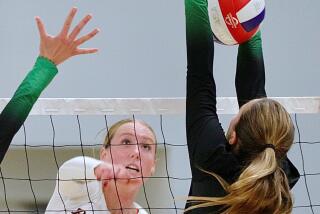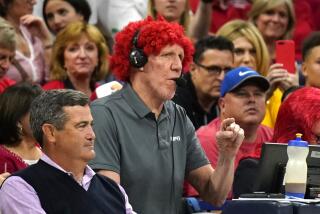Bay Ball: Hoop Stars, Weekenders Duel in the Sun at Half Court
With a scrappiness belying his 59 years and a set shot from a distant decade, Bill Lebold got his points as usual on the beach basketball court in Belmont Shore. “That looks good, Billy,” younger players with more modern abilities would say last Saturday morning just before a Lebold two-hander went through the bent hoop.
“Stay here long enough, you become a legend,” Lebold said, happy to be able to keep up in the three-on-three “bay ball” half-court games that are a tradition under the sun next to Alamitos Bay in Long Beach.
Current and former college stars, and even an occasional pro, are apt to show up to play with or against attorneys and stockbrokers who are trying to stay in shape, or guys who never heard the roar of a crowd but are forever challenging those who have.
“The competition is tremendous,” said Michael Goodwin, 30, a computer engineer who never played in school.
Knee Brace, Gold Necklace
Among Saturday’s players were John Hatten, the 6-foot-9, 250-pound Cal State Long Beach center; Danny Marques, who wore a knee brace and gold necklace and looked nearly as quick as he was as a CSULB guard in the mid-1970s; Terence Carney, a sharpshooter 10 years ago at University of the Pacific, and about a dozen regulars with middle-of-the-road talent, including Mike Patterson, who wore a red baseball cap backwards and said: “I’m 33, still playing the game at full speed. That’s not bad.”
The one thing everyone has in common, Lebold said, is love for the game.
However, they also seem to share a preference for expensive high-tech, high-top shoes--the kind designed for use on polished wood, not gritty asphalt.
Although two full courts are enclosed at the corner of Bayshore Drive and Ocean Boulevard, only one of the four baskets is used for the games--the one that has the least wind and is closest to the bikini-filled scenery on the sand beyond the fence.
Affixed to a fan-shaped metal backboard mounted atop a pole, the basket is no easy target with its rim bent down in front, a victim of the leaping youths of the Air Jordan era. Unless shot perfectly, the ball springs erratically off the rim with a ping.
Net Retaped to Rim
The net, assaulted daily by wind and jump shots, cries for a replacement. Some of its loops fly free, waiting to be retaped to the rim or tied with shoestrings.
The games are played to 11 baskets, and a team has to win by two. If a team wins, it plays the next trio of challengers and stays on the court until defeated. The players on the losing team must wait--often an hour or more--to play again.
Players call their own fouls, judgments often disputed by opponents. Wails of injustice cut through the air, though not as frequently as the profane outbursts of the maniacal handball players who have their own courts nearby.
Arguments spice the games and are resolved only after lengthy discussion. “The best debater will usually shoot do-or-die to see who gets the ball,” said Maz Trakh, a former player at Southern Utah State College who was among those sitting shirtless on lawn chairs waiting to get into a game. “If the ball goes in, he’ll say, ‘The ball don’t lie.’ That usually ticks off the other team.”
Carney, 30, the former Pacific player who is now an attorney, said there are more arguments now than when he first played at the court while in high school. “Some guys take the game too seriously and forget that out here it’s just a hobby,” said Carney, who comes out mainly for the sun and fun and to ward off the threat of an expanding waistline.
But like the others, Carney played with an intense desire to win. “You have to be fairly good or you won’t be picked and won’t get your workout in,” he said.
‘Most Dominant Player’
The king of bay ball apparently is Reggie Payne, who played at Cal State Long Beach in the early 1980s. “He’s the most dominant player,” Trakh said. “He gets picked up every time. He never sits out unless he’s tired.”
Having just lost a game, the balding Billy Lebold took his seat, sweating and muttering about errant passes.
“I hate to lose,” said Lebold, a veteran of 28 years on this court. “I always come here (from Newport Beach) to win. I hate to wait around because I get a little stiff.”
Lebold said his style is similar to what it was when he played at Washington State University in 1947: “I play a quick-moving game and I shoot really well.”
He fit in well. The victorious teams had quick players adept not at dunking but at setting screens and shooting from outside. They also had a willingness to risk landing in an edge-of-the-court garbage can while trying to save a ball from going out of bounds.
Unstoppable Under Basket
Even Hatten, the 49er center who was by far the biggest player on the court and unstoppable under the basket, preferred shooting from beyond the foul circle.
“There’s no pressure here,” Hatten said. “I don’t have to worry about missing a layup here and turning around and facing a coach. They (coaches) think we pick up bad habits here, but I think it’s good to shoot with the wind a factor. And as long as you’re playing, you’re getting in shape.”
Hatten muscled easily past Rod Brooks, a businessman who was trying to guard him.
“Too big for me . . . and a lot younger,” Brooks, 35, said, heading for his lawn chair after the defeat.
Some of the players, who had moved to California, claimed that bay ball is almost gentlemanly compared to what they are used to.
“Back East,” one of them said of playgrounds in Cleveland, Ohio, “you have to rip a guy’s arm off to get a foul.”
But out on the court, a skinny guy was trying to do just that--and more--to Hatten.
“Hey John,” yelled a courtsider. “You running out at Santa Anita? You got a saddle on your back.”
More to Read
Go beyond the scoreboard
Get the latest on L.A.'s teams in the daily Sports Report newsletter.
You may occasionally receive promotional content from the Los Angeles Times.










